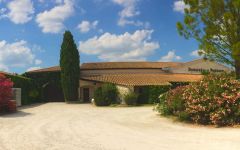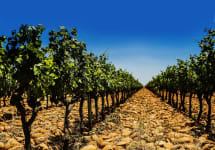Domaine de la Mordoree Chateauneuf-du-Pape La Reine des Bois 2009
-
Robert
Parker -
Wine
Spectator -
Wine
Enthusiast


Product Details
Your Rating
Somm Note
Winemaker Notes
Blend: 80% Grenache, 10% Mourvèdre, 5% Syrah, 2.5% Vaccarese, 2.5% Counoise
Professional Ratings
-
Robert Parker's Wine Advocate
The 2009 Chateauneuf du Pape Cuvee de la Reine des Bois is brilliant. A blend of 80% Grenache and the rest Mourvedre, Syrah and other approved varietals, it was aged in stainless steel (two-thirds) and smaller older barrels (one-third). Its inky purple color is followed by a gorgeous nose of blackberry and blueberry liqueur, lead pencil shavings, and a hint of raspberries. Full-bodied, rich and concentrated with abundant floral notes, stunning flavor depth, brilliant purity and sweet tannin, it will benefit from 3-4 years of bottle age (atypical for a 2009), and should drink well for 25+ years.
-
Wine Spectator
Very youthful, with lots of exuberant, richly layered blackberry, boysenberry, cassis and plum fruit flavors. The solid structure is buried deep on the spice- and anise-filled finish. Flashy, but has the stuffing to unwind nicely in the cellar. Best from 2012 through 2025. Tasted twice, with consistent notes. 2,000 cases made.
-
Wine Enthusiast
As usual at this young age, the new oak used for aging this cuvee stands out a bit, giving the plummy fruit aromas a cedary, menthol-tinged veneer. But on the palate the wine shines, from its expansive, creamy mouthfeel to the captivating flavors of brandied cherries and powdered cinamon. Drink now-2020.
Other Vintages
2020-
Jeb
Dunnuck -
James
Suckling - Decanter
-
Robert
Parker
-
Jeb
Dunnuck -
Robert
Parker -
Wine
Spectator
-
Jeb
Dunnuck -
Robert
Parker -
James
Suckling
-
Jeb
Dunnuck -
Robert
Parker -
Wine
Spectator -
Wine
Enthusiast
-
Robert
Parker
-
Robert
Parker
-
Robert
Parker -
Wine
Spectator
-
Robert
Parker -
Jeb
Dunnuck -
Wine
Enthusiast
-
Robert
Parker -
Wine
Spectator
-
Robert
Parker
-
Wine
Spectator -
Robert
Parker -
Jeb
Dunnuck -
Wine
Enthusiast
-
Robert
Parker
-
Jeb
Dunnuck -
Robert
Parker -
Wine
Spectator
-
Wine
Spectator -
Robert
Parker
-
Robert
Parker






Coming from a long line of winegrowers, the Domaine de la Mordoree was created in 1986 with the philosophy of growing the best possible wines. To that purpose, the best plots and the finest varieties have been chosen, and the winemakers implement cultivation methods that aim at really preserving the environment, while combining tradition and modernity.
In the course of time, 55 hectares of vineyards have been grown, spread over 35 different plots and 8 communes. This division comes from the decision of choosing the best "terroirs" with a wide variety of microclimates.

With bold fruit flavors and accents of sweet spice, Grenache, Syrah and Mourvèdre form the base of the classic Rhône Red Blend, while Carignan, Cinsault and Counoise often come in to play. Though they originated from France’s southern Rhône Valley, with some creative interpretation, Rhône blends have also become popular in other countries. Somm Secret—Putting their own local spin on the Rhône Red Blend, those from Priorat often include Merlot and Cabernet Sauvignon. In California, it is not uncommon to see Petite Sirah make an appearance.

Famous for its full-bodied, seductive and spicy reds with flavor and aroma characteristics reminiscent of black cherry, baked raspberry, garrigue, olive tapenade, lavender and baking spice, Châteauneuf-du-Pape is the leading sub-appellation of the southern Rhône River Valley. Large pebbles resembling river rocks, called "galets" in French, dominate most of the terrain. The stones hold heat and reflect it back up to the low-lying gobelet-trained vines. Though the galets are typical, they are not prominent in every vineyard. Chateau Rayas is the most obvious deviation with very sandy soil.
According to law, eighteen grape varieties are allowed in Châteauneuf-du-Pape and most wines are blends of some mix of these. For reds, Grenache is the star player with Mourvedre and Syrah coming typically second. Others used include Cinsault, Counoise and occasionally Muscardin, Vaccarèse, Picquepoul Noir and Terret Noir.
Only about 6-7% of wine from Châteauneuf-du-Pape is white wine. Blends and single-varietal bottlings are typically based on the soft and floral Grenache Blanc but Clairette, Bourboulenc and Roussanne are grown with some significance.
The wine of Chateauneuf-du-Pape takes its name from the relocation of the papal court to Avignon. The lore says that after moving in 1309, Pope Clément V (after whom Chateau Pape-Clément in Pessac-Léognan is named) ordered that vines were planted. But it was actually his successor, John XXII, who established the vineyards. The name however, Chateauneuf-du-Pape, translated as "the pope's new castle," didn’t really stick until the 19th century.
